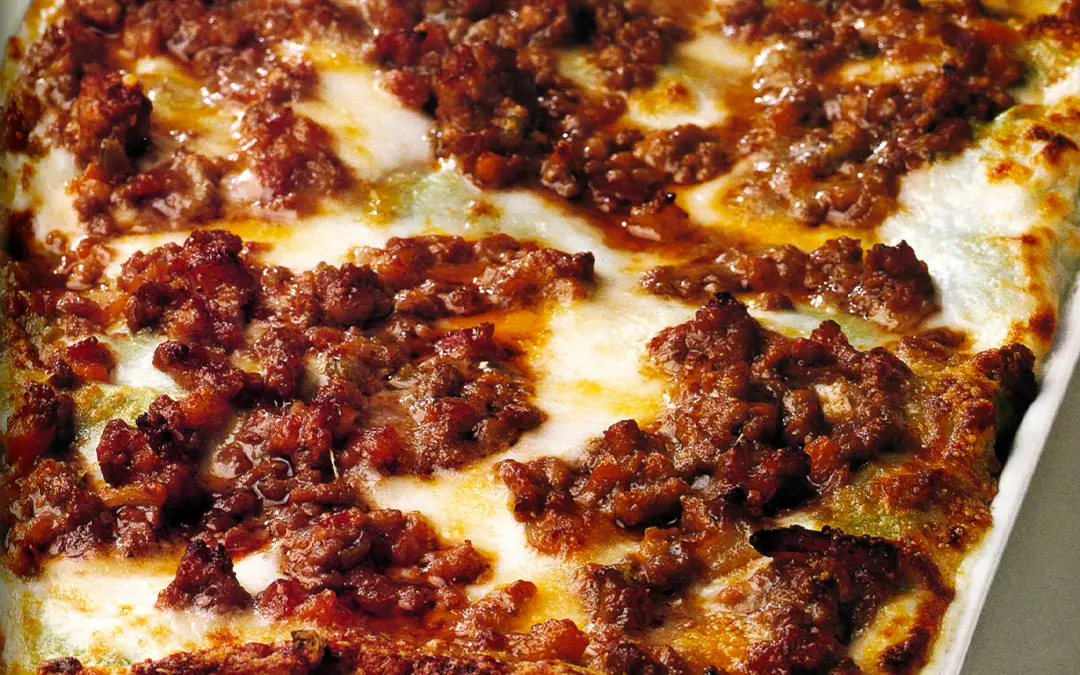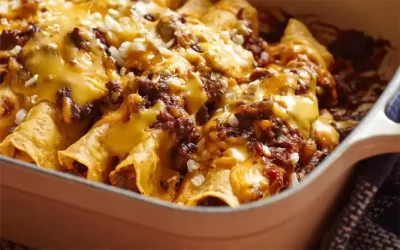Lasagne alla Bolognese: The original version of lasagna from medieval times consisted of large rectangular layers of fresh pasta separated by a simple mixture of cheese and spices. During the Renaissance, fish and shrimp were added-a delicious spin that is still common in the Veneto. Today, variations abound. In Bologna, spinach flavors and tints the noodles, which are layered with ragu alla bolognese and bechamel.
Serves 4
INGREDIENTS
1 carrot
1 small onion
1 celery rib
2 oz pancetta or bacon
3 1/2 tbl unsalted butter
1/3 ground beef
1/3 ground pork
1/4 pound prosciutto crudo
1 tbl double concentrate tomato paste
full-bodied red wine
beef broth
salt
black peppercorns
nutmeg
1 1/2 cups plus 1/2 cup flour
1 egg
1 small bunch spinach
extra-virgin olive oil
4 tbl plus 1 1/2 tbl butter
2 1/2 cups milk
Parmigiano-Reggiano cheese
INSTRUCTIONS
Ragu:
In a large saucepan, combine 1 minced small carrot, 1/2 minced small onion, 1/2 minced celery rib, 2 ounces chopped pancetta and 3 1/2 tablespoons unsalted butter. Heat over medium heat.
Stirring, lightly brown vegetables until golden in color.
Add 1/3 pound ground beef, 1/3 pound ground pork and 1/4 pound chopped prosciutto. Cook, stirring, for 2 minutes more.
Stir in 1 tablespoon tomato paste.
Add 2/3 cup broth and 1/3 cup red wine; bring to a bare simmer, partially cover, and cook, stirring occasionally, for 30 minutes. Season to taste with salt, pepper and nutmeg.
Spinach Pasta:
Boil and finely mince 1 small bunch spinach. Mound 1 1/2 cups flour in the center of a large wooden cutting board. Make a well in the middle of the flour and add 1 egg, 1 tablespoon oil and a pinch salt. Add spinach.
Using a fork, lightly beat together spinach and egg. Gradually incorporate flour, starting with the inner rim of the well.
When dough becomes too stiff to work with a fork, knead with hands until dough is no longer sticky (if dough is sticky, add more flour in tablespoon increments).
Knead dough until elastic, a few minutes more, dusting board with flour as needed. Wrap dough in plastic wrap and let rest at room temperature for 30 minutes.
Flatten dough so that it will fit through the rollers of a hand-cranked pasta machine. Set rollers to widest setting and pass dough through rollers, folding and turning pasta with each pass, 3 or 4 times. Cut into 2 pieces and, gradually decreasing pasta machine settings, roll pasta through machine (do not turn or fold) until it is about l millimeter thick and the width of the pasta machine.
Cut dough into large rectangles, the width of the pasta roller, and about 7 inches long.
Bechamel:
In a medium saucepan, heat 4 tablespoons butter and 1/2 cup flour over medium heat, stirring, until mixture is nicely colored.
In a slow and steady stream, add 2 1/2 cups milk, whisking continuously.
Simmer, stirring, until bechamel thickens, about 5 minutes. Season to taste with salt, pepper and nutmeg. Remove from the heat and add 1 to 1 1/2 tablespoons butter; stir to combine. If the bechamel is not to be used immediately, cover with plastic wrap and set aside.
Lasagna:
Heat oven to 400°. Bring a large saucepan of salted water to boil. Add lasagna sheets and cook until they float to the top of the surface, about 15 seconds.
Drain, and immediately plunge into a bowl of ice water. Drain again, and dry between two clean kitchen towels.
Cover an 11″ x 7″ x 2″ rectangular baking dish (or similar size oval gratin dish; slightly smaller is fine) with an initial layer of lasagna, letting the pasta hong over the sides of the dish if necessary.
Cover with a layer of ragu, bechamel and grated Parmigiano-Reggiono cheese. Cover with another layer of pasta, fitting snug inside the dish, and continue, making a total of 4 layers with enough bechamel, ragu and Parmigiano-Reggiano cheese leftover for the top.
To finish, fold any overflowing pasta over the dish. Top with remaining bechamel, ragu and Parmigiano-Reggiano cheese. Bake for 20 minutes. Remove from oven and let rest for 5 to 10 minutes before serving.




